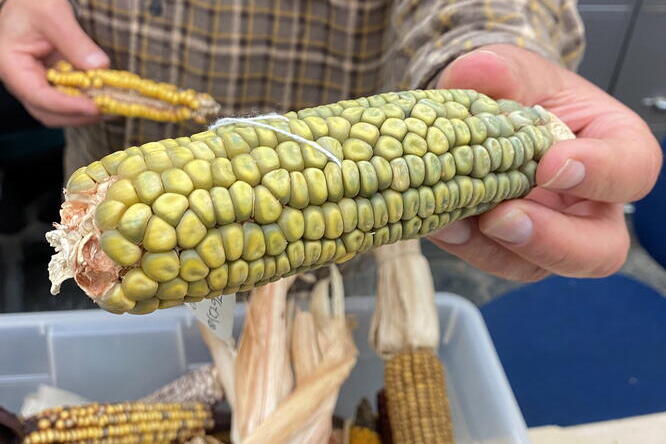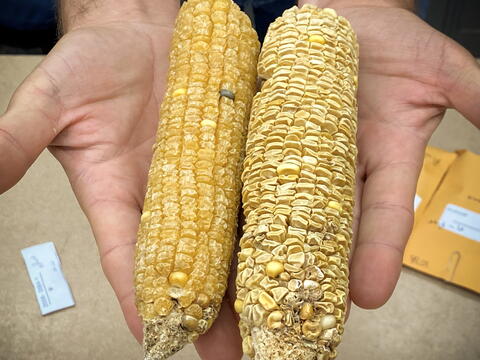Crucial mutant corn stocks threatened under 2026 USDA budget

When most growers plant corn, they expect perfect, uniform rows and plump and pearly yellow kernels lining the cob. But a group of USDA Agricultural Research Service scientists intentionally plant the misfits — some gnarled and speckled, others sprouting tassels where ears should be — to perpetuate the wide array of genetic variation in the Midwest’s most economically important crop.
The Maize Genetics Cooperation Stock Center, located on the University of Illinois Urbana-Champaign campus, contains 100,000 corn stocks representing genetic mutants. Why preserve the weirdos? Because mutant genes confer some of the most important traits in modern corn hybrids.
“Compared to the maize collection at the North Central Regional Plant Introduction Station (NCRPIS) in Ames, Iowa, which focuses on natural and breeding-derived diversity, the mutant collection is a functional genomics engine,” said Martin Bohn, professor in the Department of Crop Sciences, part of the College of Agricultural, Consumer and Environmental Sciences at Illinois. “These lines allow us to dissect gene function directly — something not possible with conventional panels. It’s the difference between observing variation and understanding its genetic basis.”
Take the sweet corn you enjoyed at your 4th of July cookout. The gene responsible for its bursting sweetness and long shelf life — shrunken2 — was first identified by U. of I. professor John Laughnan, who was experimenting in the collection in the early 1950s. From there, Illini Supersweet Corn was born. The crop has since been improved further, growing into a major summertime staple — and a major boon for agribusinesses.

“Without the stock center, sweet corn would be a little less sweet. And Illinois Foundation Seed, Inc.’s sweet corn research wouldn’t be here today,” said Charlie Thompson, vice president and director of research for IFSI’s vegetable business unit. “IFSI worked with U. of I. in those early years. We were the first to market Dr. Laughnan’s sweet corn hybrids, which were a primary driver for our business. It’s cool that a local connection has had such a global impact.”
Thompson’s Central Illinois-based team, like other companies and research groups around the world, routinely dips into the collection to improve corn traits, including disease resistance and stress tolerance. That’s possible because, as part of the USDA’s National Plant Germplasm System, seeds are made freely available to any requestor.
Enabling innovation
Among the most frequent requestors are U. of I. crop sciences professors, who use the stock center for basic and applied research, not to mention training the next generation of corn breeders and geneticists.
For example, Bohn, along with College of ACES faculty and graduate students, recently used the collection to identify genes that influence the root microbiome, revealing that corn can actively select for microbes that suppress nitrogen loss or even promote nitrogen fixation.
“These insights are now informing breeding strategies aimed at reducing fertilizer inputs and improving environmental outcomes,” Bohn said. “None of this would be possible without access to the materials provided by the maize stock center.”
Crop sciences professor Steve Moose says the advancements coming out of the stock center are innumerable, in part because the collection enables basic genetics research that informs commercial innovation years down the line. For example, current industry excitement over short corn — shorter-statured plants that may reduce lodging, increase harvest efficiency, and achieve greater yield — originated from short mutants in the collection.
To make all of these innovations possible, the ARS scientists who run the facility — which consists of three large and precisely calibrated cold storage rooms, a laboratory, and office spaces in College of ACES buildings — meticulously catalog the collection’s 100,000 corn stocks, leveraging their deep knowledge of the genes and traits represented in each stock to advise requestors and pack seeds for shipment. They also grow the stock collection on a 12-year cycle to replenish fresh seeds. It’s a big job for a few very specialized experts, but it works.

“You touch it, you break it.”
Despite the stock center’s efficient, smooth operation, low operating costs, and industry support, the corn genetics community is concerned about the facility’s future. That’s because, in early June, the ARS location in Urbana — which operates both the Maize Genetics Cooperation Stock Center and the National Soybean Germplasm Collection — appeared on a short list of ARS facilities slated for closure and consolidation as part of the proposed 2026 USDA budget. Under the plan, the stock center would be consolidated with the North Central Regional Plant Introduction Station (NCRPIS) in Ames, Iowa.
The survival of the invaluable collection depends on seeds held at precise temperature and humidity set points. Transporting 100,000 stocks and building the required facilities in a new location pose real challenges to the collection’s integrity. And experts argue there’s little to no benefit to consolidation.
“The stock center is historically rooted at the University of Illinois, and the concentration of expertise, infrastructure, and institutional continuity in Urbana is unmatched and irreplaceable. I also question whether NCRPIS can realistically absorb the stock center without substantial investments in both facilities and personnel. Relocating it would disrupt ongoing research and put a globally unique resource at risk,” Bohn said. “In my view, if you touch it, you break it.”
Legislators and industry groups are voicing support to maintain the three ARS locations facing consolidation, resulting in report language from the House appropriations committee that it “rejects proposed research program terminations.” USDA’s proposal to relocate, rather than terminate the collections and programs outright, may render that advice moot, however. The USDA budget and any enforceable statutory language related to relocation are currently under consideration by the Senate appropriations committee, with full Congressional votes to come. In the meantime, advocates continue to make their case against consolidation.
Brad Stotler, director of government affairs for the Illinois Corn Growers Association, is one of those advocates. “Relocating the collection risks the loss of critical institutional knowledge and slows progress on research that benefits American agriculture — all at significant and unnecessary expense,” he said. “The ARS facility in Urbana and the unique collections of soybeans and maize housed there are critically important to advancing genetic research and improving American agriculture. The maize collection has 72 years of history on the Illinois campus, and it's more important than ever to invest in these programs and protect the well-established research collaboration between ARS and U. of I. scientists.”